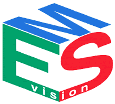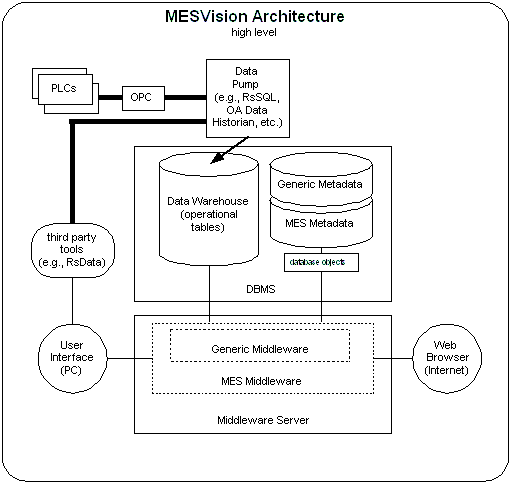Manufacturing Execution Systems
Background
|
Manufacturing
Yields:
- Product
- Scrap
- Waste
- Data
By
properly managing the last item, you gain significant control
over the first three.
|
Regardless of company size, manufacturing
is an extremely competitive industry.
To compete in today's global market, reliable data is essential
to manage the individual operations that comprise the manufacturing
process. Recently, process and manufacturing engineers have begun
exploring the notion of exploiting the wealth of data generated
and often discarded with each control cycle. These approaches include:
Integrating shop floor processes with relational
database management systems (RDBMS), to regulate and refine the
production line.
Utilizing the data generated by programmable
logic controllers (PLC) which are commonly configured on shop floor
intranets/LANs.
Likewise, many IT managers have begun to
consider the value in:
Linking corporate enterprise resource planning
(ERP) and supply chain planning (SCP) data with manufacturing data
across one or more product lines.
Associating day-to-day production data with
more strategic data, to achieve more accurate planning and resource
scheduling.
MES Defined
Manufacturing Control Systems (MCS) are
routinely used by shop floor operators and engineers for process
control and to automate production. A Manufacturing Execution
System (MES) provides a layer of robust engineering functionality
beyond the shop floor. This second tier typically rests on
top of the MCS layer, and directly under the corporate IT layer
where ERP and other high end systems reside. Unlike the MCS,
which is implemented across individual processes, MES ties all operations
together and treats them as a coherent unit. Simply stated,
MES is the big picture for what is happening on the manufacturing
line at any given time. The MES layer provides the ideal connection
point to implement real-time production control leading to, among
other things:
 Reliable
real-time data archival from the shop floor Reliable
real-time data archival from the shop floor - Historical trending, and statistical
process control (SPC)
- Material lot and expiration control
- Complete product genealogy
- Work-in-progress reduction
- Event and alarm management
- Batch and recipe administration
- Inventory control
The PowerVision Approach to MES
PowerVision's Manufacturing Sector provides
complete life cycle support for all manufacturing based systems.
We utilize vision@workSM to ensure the success of every project–
from the simplest operator interface, to the most comprehensive
MES platform design. Our engineers bring unique approaches to the
task:
We emphasize planning and design as much
as development and integration, knowing that the up-front work pays
off in a smoother, more successful deployment of your system.
Early in the planning process, we work directly
with both managers and end users to identify how the manufacturing
processes, present and proposed information systems, and the users
need to interact for the best results.
- We extensively use prototyping to identify
both functional as well as usability issues.
- We create a comprehensive functional
specification to fully describe the system's requirements.
This eliminates any last minute surprises; instead, the system
does exactly what you need it to do.
- We develop a detailed design specification,
which acts as the blueprint for application development and systems
integration.
- We work with you to jointly create a
test plan to thoroughly ensure that the system will fully meet
everyone's expectations.
- We ensure the your satisfaction with
each development phase by a walkthrough and sign-off.
Our MES Architecture
PowerVision engineers develop open object-oriented
system architectures, because we recognize that most manufacturing
platforms consist of many applications working together—generally
from different vendors. Over time, MES will become even more
heterogeneous with the increased utilization of web interfaces,
remote databases and distributed processes. Contributing to
this trend is the best-of-breed design approach, which allows a
system to utilize components from many different vendors, based
strictly on their level of functionality and performance.

PowerVision's manufacturing specialists take the
long-term view in developing systems that are scalable and extensible
at every point, because in today's market, proprietary systems with
their built-in obsolescence are unacceptable. PowerVision's
MESVisionSM framework allows legacy control and information systems
to seamlessly integrate with contemporary MES services based on
COM and DCOM. Accordingly, data can be readily transferred
between the MES and your existing ERP system. Functionality
can be added as needed without adversely affecting older, more proprietary
platforms. Information can be accessed and reviewed via web
browser or through more traditional front-end interfaces, such as
those developed in Visual Basic, Visual C++, Delphi or Java.
Benefits
While many different levels of functionality
can be implemented on a given production line, even an entry level
system that provides basic data collection and analysis services
will yield a substantial return on investment (ROI) in terms of
higher quality product as well as increased manufacturing productivity—too
often seen as competing interests. These results include:
- Significant time and cost savings.
The difference between compiling a complex report using traditional
paper-based methods and electronic data retrieval is typically
greater than two orders of magnitude—more than 100 times faster!
For one customer, a detailed monthly Statistical Process Control
(SPC) report run across several molding operations that previously
took 70 to 80 hours to manually compile now takes less than a
minute.
- Improved quality due to the ability to
carry out historical trending, qualitative analysis and to rapidly
trace defective final products back to specific raw material lots
and operations. Data analysis often reveals subtle, yet
potentially serious processing issues.
- Higher levels of process efficiency facilitated
through operational analysis to quickly reveal production bottlenecks.
- Rapid material-to-product pedigree and
work-in-progress (WIP) tracking.
- Lower scrap, fewer reworks and more importantly
– less waste.
- Easier ISO 9000 compliance due to readily
available material and processing genealogy. Documentation
services can be integrated within the MES to provide instant access
to processing and testing procedures.
- Better security, tailored to each operation,
but which can be administered from one centralized location.
Conclusion
A well designed MES platform provides a rapid
and substantial ROI in both cost and time savings. The net
result of MES technology is higher manufacturing throughput, tighter
production control, increased product quality and a greatly enhanced
ability to respond the dynamics of a contemporary manufacturing
environment.
TRADEMARKS. PowerVision, We Make IT Happen!,
vision@work, and MESVision are service marks of PowerVision Corporation.
Other product and company names mentioned herein may be the trademarks
of their respective owners.
|











